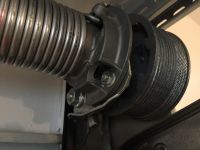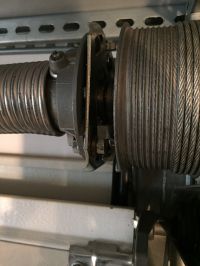I have a problem with Hormann's gate. The spring broke in the gate after 11 years of use, and therefore both springs were replaced with new ones. Left 722 law 723.
Spring tension for 9.5 turns according to the nameplate on the gate.
The problem is that after such a tension the gate should move slightly down and up and with the disconnected drive should stabilize about 1m from the ground (according to information from the company in which I bought the springs). Unfortunately, this is not happening. After fastening the drive, the drive opened the gate but it did not close. Drive off from overload when trying to lower. Evidently, something is wrong because the gate opened, it was heard loud like a rattle from the right drum on which the cord is wound. I think something is blocking there.
With free springs and an unbonded connector of the rod on which the springs are, after releasing the lock, each of the drums rotates slightly, while as the drums are fastened with a link rod this unblocking does not allow rotation. To turn the bar, both reels must be manually unlocked.
Where to look for a problem?
Spring tension for 9.5 turns according to the nameplate on the gate.
The problem is that after such a tension the gate should move slightly down and up and with the disconnected drive should stabilize about 1m from the ground (according to information from the company in which I bought the springs). Unfortunately, this is not happening. After fastening the drive, the drive opened the gate but it did not close. Drive off from overload when trying to lower. Evidently, something is wrong because the gate opened, it was heard loud like a rattle from the right drum on which the cord is wound. I think something is blocking there.
With free springs and an unbonded connector of the rod on which the springs are, after releasing the lock, each of the drums rotates slightly, while as the drums are fastened with a link rod this unblocking does not allow rotation. To turn the bar, both reels must be manually unlocked.
Where to look for a problem?





